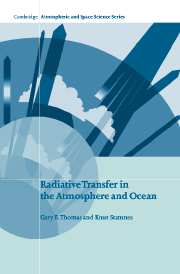Book contents
- Frontmatter
- Contents
- List of Illustrations
- Preface
- Acknowledgments
- Chapter 1 Basic Properties of Radiation, Atmospheres, and Oceans
- Chapter 2 Basic State Variables and the Radiative Transfer Equation
- Chapter 3 Basic Scattering Processes
- Chapter 4 Absorption by Solid, Aqueous, and Gaseous Media
- Chapter 5 Principles of Radiative Transfer
- Chapter 6 Formulation of Radiative Transfer Problems
- Chapter 7 Approximate Solutions of Prototype Problems
- Chapter 8 Accurate Numerical Solutions of Prototype Problems
- Chapter 9 Shortwave Radiative Transfer
- Chapter 10 Transmission in Spectrally Complex Media
- Chapter 11 Radiative Transfer in Nongray Media
- Chapter 12 The Role of Radiation in Climate
- Appendices
- Index
Chapter 3 - Basic Scattering Processes
Published online by Cambridge University Press: 18 December 2009
- Frontmatter
- Contents
- List of Illustrations
- Preface
- Acknowledgments
- Chapter 1 Basic Properties of Radiation, Atmospheres, and Oceans
- Chapter 2 Basic State Variables and the Radiative Transfer Equation
- Chapter 3 Basic Scattering Processes
- Chapter 4 Absorption by Solid, Aqueous, and Gaseous Media
- Chapter 5 Principles of Radiative Transfer
- Chapter 6 Formulation of Radiative Transfer Problems
- Chapter 7 Approximate Solutions of Prototype Problems
- Chapter 8 Accurate Numerical Solutions of Prototype Problems
- Chapter 9 Shortwave Radiative Transfer
- Chapter 10 Transmission in Spectrally Complex Media
- Chapter 11 Radiative Transfer in Nongray Media
- Chapter 12 The Role of Radiation in Climate
- Appendices
- Index
Summary
Introduction
In the next two chapters we will study the physical basis for the three types of light–matter interactions that are important in planetary media – scattering, absorption, and emission. In this chapter we concentrate on scattering, which may be thought of as the first step in both the emission and absorption processes. The classical concept of the Lorentz atom is first used to visualize the process of scattering, which encompasses both coherent processes, such as refraction and reflection, as well as the many incoherent processes that comprise the main topics of this chapter.
Consideration of the classical interaction of a plane wave with an isolated damped, simple harmonic oscillator helps to introduce the concept of the cross section. The scattering cross section is expressed in terms of the frequency of the incident light, the natural frequency of the oscillator, and the damping rate. A simple extension of the concept is then made to scattering involving excited quantum states. This approach also helps to understand three different scattering processes (Rayleigh, resonance, and Thomson scattering) using one unified description. It also gives the Lorentz profile for absorption in terms of the classical damping rate, which apart from a numerical constant agrees with the quantum mechanical result. This approach also allows for a description of the two principal mechanisms responsible for broadening of absorption lines in realistic molecular media: pressure broadening and Doppler broadening.
Radiation interacts with matter in three different ways: through emission, absorption, and scattering.
- Type
- Chapter
- Information
- Radiative Transfer in the Atmosphere and Ocean , pp. 56 - 83Publisher: Cambridge University PressPrint publication year: 1999
- 2
- Cited by



